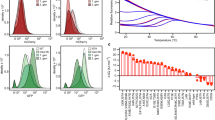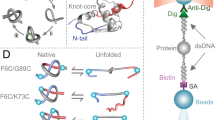Abstract
BASIC pancreatic trypsin inhibitor (BPTI) is a protein of fifty-eight amino acid residues, which inhibits the serine proteinases trypsin, chymotrypsin, plasmin and kallikrein. The sequence has been fully elucidated1 (Fig. 1) and the three-dimensional structure has been determined to high resolution by X-ray crystallography2,3. In connection with studies on the partial synthesis of analogues of BPTI for the investigation of protein folding, we have examined in detail cleavage of the protein by cyanogen bromide4. We have found that the chain-cleaved product is unstable, and that on standing it is spontaneously transformed into an analogue of BPTI containing an intact chain of fifty-eight amino acid residues.
This is a preview of subscription content, access via your institution
Access options
Subscribe to this journal
Receive 51 print issues and online access
$199.00 per year
only $3.90 per issue
Buy this article
- Purchase on Springer Link
- Instant access to full article PDF
Prices may be subject to local taxes which are calculated during checkout
Similar content being viewed by others
References
Kassell, B., and Laskowski, sen., M., Biochem. biophys. Res. Commun., 18, 255 (1965).
Huber, R., Kukla, D., Ruhlmann, A., Epp, O., and Formanek, H., Naturwissenschaften, 57, 389 (1970).
Huber, R., Kukla, D., Ruhlmann, A., and Steigmann, W., Proc. Int. Res. Conf. Proteinase Inhibitors 1970, 56 (Walter de Gryter, Berlin, 1971).
Gross, E., and Witkop, B., J. Am. Chem. Soc., 83, 1510 (1961).
Kassell, B., Biochemistry, 3, 152 (1964).
Averini-Goldman, R., Snir, I., Blauer, G., and Rigbi, M., Arch. Biochem. Biophys., 121, 107 (1967).
Sach, E., Thely, M., and Choay, J., C.r. hebd. Séanc. Acad. Sci., Paris, 260, 3491 (1965).
Ambler, R. P., Biochem. J., 96, 32P (1965).
Light, A., in Methods in Enzymology, 25, 253 (Academic, New York, 1972).
Chauvet, J., Nouvel, G., and Acher, R., Biochim. biophys. Acta, 115, 130 (1966).
Kassell, B., and Laskowski, sen., M., Biochem. biophys. Res. Commun., 17, 792 (1964).
Kassell, B., in Methods in Enzymology, 19, 844 (Academic, New York, 1970).
Zerner, B., Bond, R. P. M., and Bener, M. L., J. Am. Chem. Soc., 86, 3674 (1964).
Ruhlmann, A., Kukla, D., Schwager, P., Bartels, K., and Huber, R., J. molec. Biol., 77, 417 (1973).
Offord, R. E., Biochem. J., 129, 499 (1972).
Author information
Authors and Affiliations
Rights and permissions
About this article
Cite this article
DYCKES, D., CREIGHTON, T. & SHEPPARD, R. Spontaneous Re-formation of a Broken Peptide Chain. Nature 247, 202–204 (1974). https://doi.org/10.1038/247202a0
Received:
Issue Date:
DOI: https://doi.org/10.1038/247202a0
This article is cited by
-
Immunological and receptor-binding properties of fragments resulting from cyanogen bromide cleavage of bovine growth hormone
Journal of Protein Chemistry (1983)
Comments
By submitting a comment you agree to abide by our Terms and Community Guidelines. If you find something abusive or that does not comply with our terms or guidelines please flag it as inappropriate.



